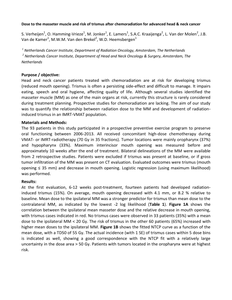Purpose: Head and neck cancer (HNC) treatment often leads to physical and psychosocial impairments. Rehabilitation can overcome these limitations and improve quality of life. The aim of this study is to obtain an overview of rehabilitation care for HNC, and to investigate factors influencing rehabilitation provision, in Dutch HNC centers, and to some extent compare it to other countries. Methods: An online survey, covering five themes: organizational structure; rehabilitation interventions; financing; barriers and facilitators; satisfaction and future improvements, among HNC healthcare- and financial professionals of Dutch HNC centers. Results: Most centers (86%) applied some type of rehabilitation care, with variations in organizational structure. A speech language therapist, physiotherapist and dietitian were available in all centers, but other rehabilitation healthcare professionals in less than 60%. Facilitators for providing rehabilitation services included availability of a contact person, and positive attitude, motivation, and expertise of healthcare professionals. Barriers were lack of reimbursement, and patient related barriers including comorbidity, travel (time), low health literacy, limited financial capacity, and poor motivation. Conclusion: Although all HNC centers included offer rehabilitation services, there is substantial practice variation, both nationally and internationally. Factors influencing rehabilitation are related to the motivation and expertise of the treatment team, but also to reimbursement aspects and patient related factors. More research is needed to investigate the extent to which practice variation impacts individual patient outcomes and how to integrate HNC rehabilitation into routine clinical pathways.
MULTIFILE

Purpose / objective: Head and neck cancer patients treated with chemoradiation are at risk for developing trismus (reduced mouth opening). Trismus is often a persisting side-effect and difficult to manage. It impairs eating, speech and oral hygiene, affecting quality of life. Although several studies identified the masseter muscle (MM) as one of the main organs at risk, currently this structure is rarely considered during treatment planning. Prospective studies for chemoradiation are lacking. The aim of our study was to quantify the relationship between radiation dose to the MM and development of radiation-induced trismus in an IMRT-VMAT population. Results: At the first evaluation, 6-12 weeks post-treatment, fourteen patients had developed radiation-induced trismus (15%). On average, mouth opening decreased with 4.1 mm, or 8.2 % relative to baseline. Mean dose to the ipsilateral MM was a stronger predictor for trismus than mean dose to the contralateral MM, as indicated by the lowest -2 log likelihood (Table 1). Figure 1A shows the correlation between the ipsilateral mean masseter dose and the relative decrease in mouth opening, with trismus cases indicated in red. No trismus cases were observed in 33 patients (35%) with a mean dose to the ipsilateral MM < 20 Gy. The risk of trismus in the other 60 patients (65%) increased with higher mean doses to the ipsilateral MM. Figure 1B shows the fitted NTCP curve as a function of the mean dose, with a TD50 of 55 Gy. The actual incidence (with 1 SE) of trismus cases within 5 dose bins is indicated as well, showing a good correspondence with the NTCP fit with a relatively large uncertainty in the dose area > 50 Gy. Patients with tumors located in the oropharynx were at highest risk.
DOCUMENT

Already at diagnosis, head and neck cancer patients are atrisk for malnutrition. Local symptoms such as swallowingproblems are a major cause of malnutrition in thesepatients.1 Additionally, malnutrition may result fromchanges in smell and taste/aversion and loss of appetite.Presence of these systemic symptoms at diagnosis may beindicative for the cachexia syndrome. Therefore, we testedthe hypothesis that head and neck cancer patients to betreated with primary or postoperative (chemo)radiationsuffer from cachexia.
DOCUMENT
Relatie tussen spiermassa en vroegtijdig stoppen van chemotherapie bij patienten met hoofd-halskankerIn this study, we aim to assess whether low pre-treatment muscle mass, measured with CT at thoracic (T4) or lumbar level (L3) is associated with early termination of chemotherapy related to toxicity in head and neck cancer (HNC) patients.
In dit onderzoek wordt de uitvoerbaarheid van een bewegingsprogramma tijdens chemoradiatie bij patienten met hoofd-halskanker onderzocht.The feasibility of an exercise intervention during CRT in HNSCC patients will be studied to design an optimal, large-scale RCT comparing the exercise intervention during CRT to usual care (UC) with the aim of a beneficial effect on the tolerability of CRT and physical fitness, body composition, fatigue and QoL on the longer term.